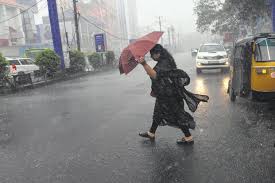With the weather department issuing a 'red alert' for rain in Mumbai, the Maharashtra government declared a holiday for schools and colleges in the
city on Thursday.
However, as people geared up to tackle the situation, the high rainfall warning turned out to be a damp squib as the city hardly received any showers till Thursday afternoon.
While the city received some showers late Wednesday night, it remained almost dry on Thursday. The school education minister Ashish Shelar's order
for the closure of schools and colleges issued late Wednesday night also remained ineffective, as several educational institutions in the city and suburbs remained open.
The Indian Meteorological Department (IMD) on Wednesday issued a red rain alert, indicating "extremely heavy rainfall", for Mumbai and Raigad districts.
The irregular heating and cooling of the Arabian Sea and the Bay of Bengal pushed cloud precipitation in Mumbai to a new high, with the city recording its wettest monsoon season this year since 1954.
When contacted, an IMD official said, "This year there has been continuous depression over Madhya Pradesh at regular intervals, which increased the overall rainfall in Mumbai and neighbouring districts."
"The state capital has received total 3,467 mm rain from June 1 till September 17, surpassing the 3,451 mm downpour recorded in 1954. With 11 days more to go this month, the city will get a record rainfall figure by then," he said.
The cyclonic circulation and related low-pressure over south Madhya Pradesh has been driving the humid westerly winds from the Arabian sea.
As the circulation gradually moves westward in the next few days, the coastal areas of the state, including Mumbai, are likely to witness very heavy rains, the official said.
According to a weather expert, the country is going through a strong 'Indian Ocean Dipole' (an irregular oscillation of sea-surface temperatures) and it is driving the intensity of showers across various places, including Mumbai.
The south-west monsoon arrived in Mumbai this year on June 18, as against the normal onset date of June 7. Repeated low-pressure formation over north Bay of Bengal and Odisha resulted in at least 25 per cent excess rainfall in central India, with the Konkan and Goa regions receiving close to 60 per cent excess downpour so far, the expert said.
Latest India News
